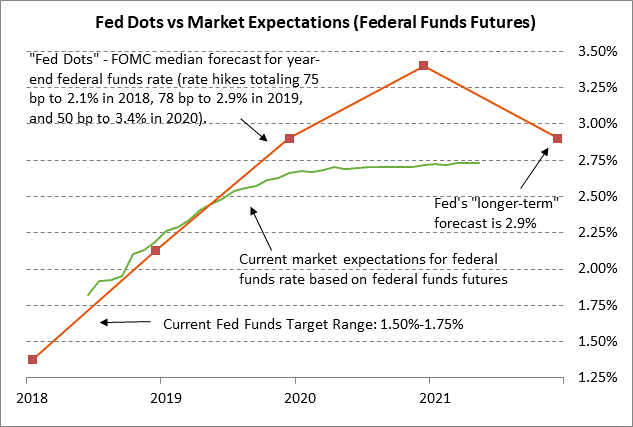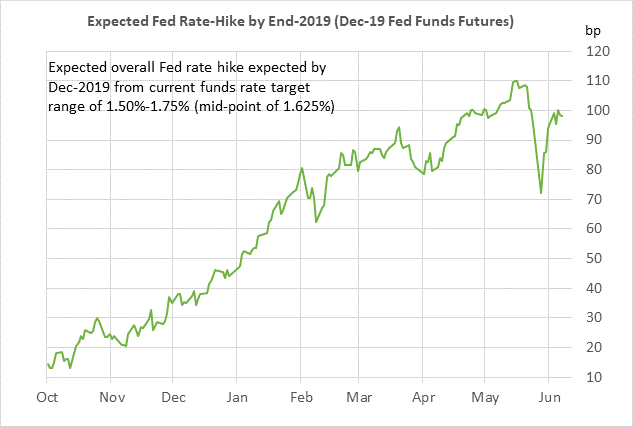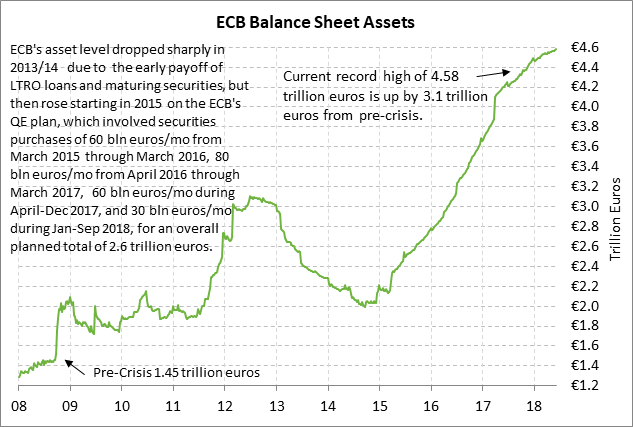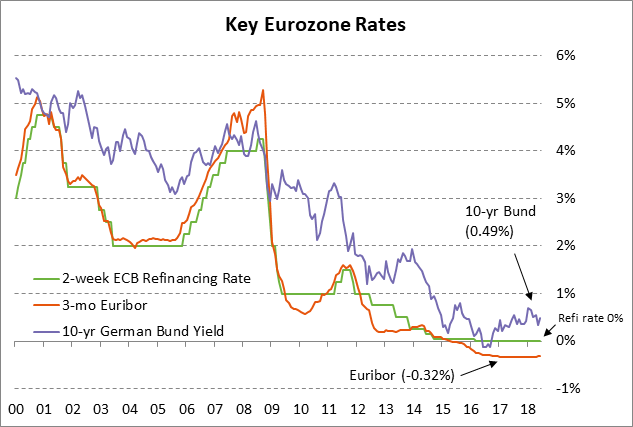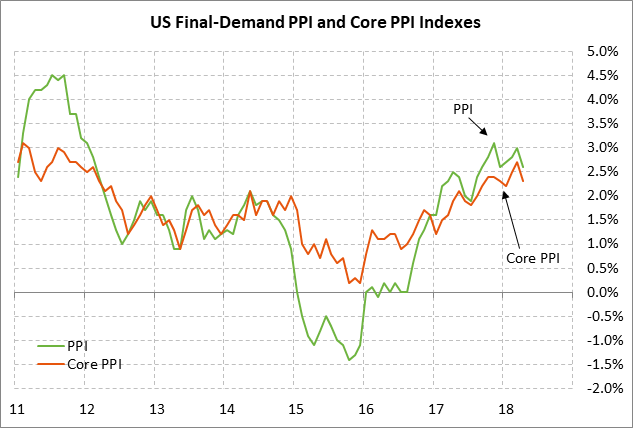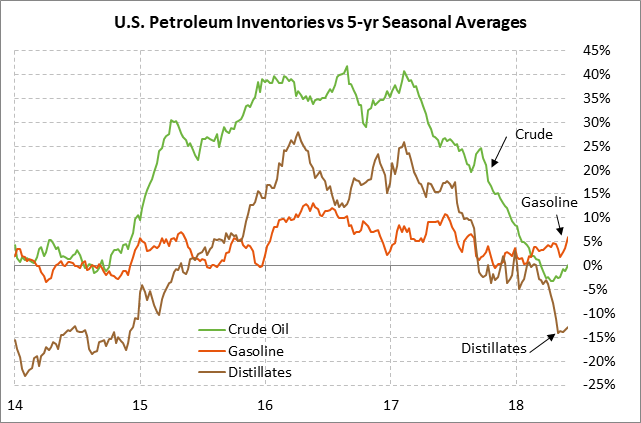- FOMC meeting concludes today with a market focus on Fed dots and IOER
- ECB on Thursday may announce the end of its QE program
- U.S. PPI expected to contribute to the stronger May inflation picture
FOMC meeting concludes today with a market focus on Fed dots and IOER — The market is unanimously expecting the FOMC at its 2-day meeting that concludes today to raise its funds rate target range by +25 bp to 1.75%/2.00%. That would be the second rate hike of the year following the March rate hike. Fed Chair Powell will hold a press conference following today’s meeting and the Fed will release an updated set of macroeconomic forecasts.
Since a rate hike today is a foregone conclusion, the market is mainly focused on any change in the Fed-dot forecasts for the funds rate. Market expectations for future rate hikes are fairly close to the Fed dots through mid-2019, but the market after that is then substantially more dovish than the Fed. In fact, the FOMC is forecasting a 25-50 bp higher funds rate during 2020-2022 than the market is expecting.
FOMC members think they will have a clear shot for steady rate hikes through 2020, but the markets think the Fed is going to run into a brick wall in late 2019 and fail to be able to raise the funds rate any higher than 2.75%. That brick wall could involve any number of problems including (1) a recession, (2) a global trade war, (3) banking system problems from higher interest rates, (4) an overseas financial crisis such as a Eurozone or Chinese meltdown, or (5) geopolitics.
The markets today will also be watching where the Fed sets its new IOER rate (interest on excess reserves), which is the interest rate that the Fed pays banks on their excess reserves held at the Fed. There is a good chance that the Fed today will raise the IOER rate by only +20 bp to 1.95%, which would be less than the typical +25 bp hike to match the new upper 2.00% limit of the Fed’s new funds rate target range. A +20 bp hike in the IOER rate today, versus a +25 bp hike, would be a slightly dovish outcome for the money markets since it would suggest a 5 bp lower new effective funds rate.
The funds rate has recently been trading at 1.70%, which is only 5 bp below the upper end of the Fed’s current target range of 1.50%/1.75%. If the Fed sets the new IOER 5 bp below the new 2.00% upper limit of the funds rate target, then the effective funds rate should be near 1.90%, i.e., closer to the middle of the 1.75%/2.00% target range.
Looking ahead, the market over the next 1-1/2 years is expecting +98 bp of Fed rate hikes (including today’s expected +25 bp rate hike) from the current mid-point funds rate target of 1.63%. That is down by 12 bp from the peak of +110 bp seen in mid-May. Market expectations for Fed rate hikes through 2019 have eased a bit in recent weeks mainly because of (1) the Italian political crisis that caused worries about the Eurozone economy, and (2) the recent decline in oil prices that has helped cool inflation expectations a bit. The 10-year breakeven inflation expectations rate is currently at 2.14%, which is 7 bp below the mid-May 3-3/4 year high of 2.21%.
ECB on Thursday may announce the end of its QE program — The ECB at its meeting tomorrow will formally discuss the end of its QE program, which is currently scheduled only through September. A recent Bloomberg survey found that about a third of the respondents expect the ECB tomorrow to announce an ending date for QE, whereas about half of the respondents believe the ECB will wait until the July meeting to reveal the QE details.
Whenever the ECB does make its QE announcement, the market consensus is for the ECB to taper its QE program from its current level of 30 billion euros per month to 10 or 15 billion euros per month in Q4-2018 and then allow the program to end altogether at the end of 2018. The markets would receive a hawkish shock in the unlikely event that the ECB instead decides to end its QE program at the end of September. The ECB has already said that after ending its QE program, it will reinvest the proceeds of maturing securities by buying new securities, thus ensuring that its balance sheet remains constant. Without that reinvestment, the ECB’s balance sheet would slowly decline and therefore would tighten monetary policy.
The markets will also carefully watch the ECB’s interest rate guidance to see if there is any chance in the current language that rates will remain unchanged “well past” the end of the QE program. The market consensus is that the ECB will raise its -0.40% deposit rate in Q2-2019 and its refinancing rate of zero in Q3-2019, according to a recent survey by Bloomberg.
U.S. PPI expected to contribute to the stronger May inflation picture — The market consensus is for today’s May final-demand PPI report to rise to +2.8% y/y from April’s +2.6%, while the May core PPI is expected to be unchanged from April’s +2.3%. Today’s expected report of +2.8% would leave the headline PPI just 0.3 points below the 6-1/4 year high of +3.1% posted in Nov 2017. Today’s expected April core PPI report of +2.3% would leave the series just 0.4 points below March’s 6-year high of +2.7%.
There could be some upside risk for today’s PPI report based on yesterday’s strong CPI report. The May CPI rose to a 6-1/4 year high of +2.8% y/y from April’s +2.5% and the May core CPI rose to a 16-month high of +2.2% y/y from +2.1%. Both reports were in line with market expectations.
Weekly EIA report — The market consensus for today’s weekly EIA report is for a -1.5 mln bbl drop in U.S. crude oil inventories, a +1.0 mln bbl rise in gasoline inventories, and a +500,000 bbl rise in distillate inventories. U.S. crude oil inventories are +0.2% above the 5-year average, while gasoline inventories are +6.1% above average and distillate inventories are -12.9% below average. U.S. oil production in last week’s EIA report rose by +0.3% w/w to a new record high of 10.800 million bpd.

